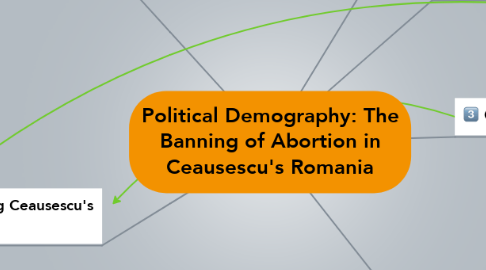
1. Post-Ceausescu's Romania
1.1. Consisted of 2 phases
1.1.1. Recognized and protected the rights of individuals in society
1.2. Revolution in December 1989
1.2.1. Liberated citizens
1.2.2. Ceausescu was executed
1.2.3. Abortion became fully legal
1.2.3.1. Women had control over their lives
1.2.3.1.1. Essential component of democratic practice
1.3. International adoptions
1.3.1. Known as "baby trading"
1.3.1.1. Children became part of Romania's exported goods
1.3.1.1.1. Practice was stopped in 1991
2. Romanian state during Ceausescu's regime
2.1. Assumed legal responsibility for the family
2.2. Protected marriage and the family
2.3. Supported the development and strengthening of the family through economic and social measures
2.4. Defended interests of mother and child
2.5. Displayed special care for the upbringing and education of the young generation
2.6. Law 770/1966
2.6.1. Prohibited abortion except if pregnancy endangered life of the woman, hereditary disease, rape-involved pregnancy, women over 45, women who delivered and reared 4 or more children
2.6.2. Birth rate declined in 1983 due to illegal abortions and abstinence and as a result, the material conditions of everyday life deteriorated
2.6.2.1. Winters were endured with little or no heat and electric
2.6.2.2. Food was rationed
3. Romania
3.1. Socialist form of government
3.1.1. Complete rule over citizens
3.1.2. Productionist mentality
3.2. Paternalist state
3.2.1. Set practices centered on the family
3.3. Pronatalist policies
3.3.1. Promotes reproduction
3.3.2. Main goal was to secure an adequate workforce
3.3.3. Meant to build up socialism
4. The Romanian family
4.1. Primary contribution to socialism is reproduction and education
4.1.1. Contribution of each citizen is made according to his/her abilities
4.2. Women
4.2.1. Childbearing
5. Women in Romania
5.1. Contribution to Romanian state centers on childbearing
5.1.1. Women receive social assistance
5.1.1.1. Guaranteed maternity leave
5.1.1.2. Job security
5.1.1.3. Childcare facilities
5.2. In the workforce
5.2.1. Low-status, poorly paid jobs
5.2.1.1. Agriculture
5.3. Work in state sphere, housework, and raise children
5.3.1. Prepare Project Review
5.3.2. Conduct Project Review
5.3.3. Implement Process Improvement
5.4. Encouraged to reproduce with financial allowances, child support benefits, maternity leave, and childcare services
6. Ceausescu's Regime
6.1. Romanian state intruded into the intimate lives of its citizens
6.2. Pronatalism
6.2.1. Made abortion illegal
6.2.2. Child abandonment rose
6.2.3. Infantile AIDS
6.3. Constitution and Family code laid groundwork for active political-educational campaigns and positive incentives
6.3.1. Right to work and equal pay for equal pay
